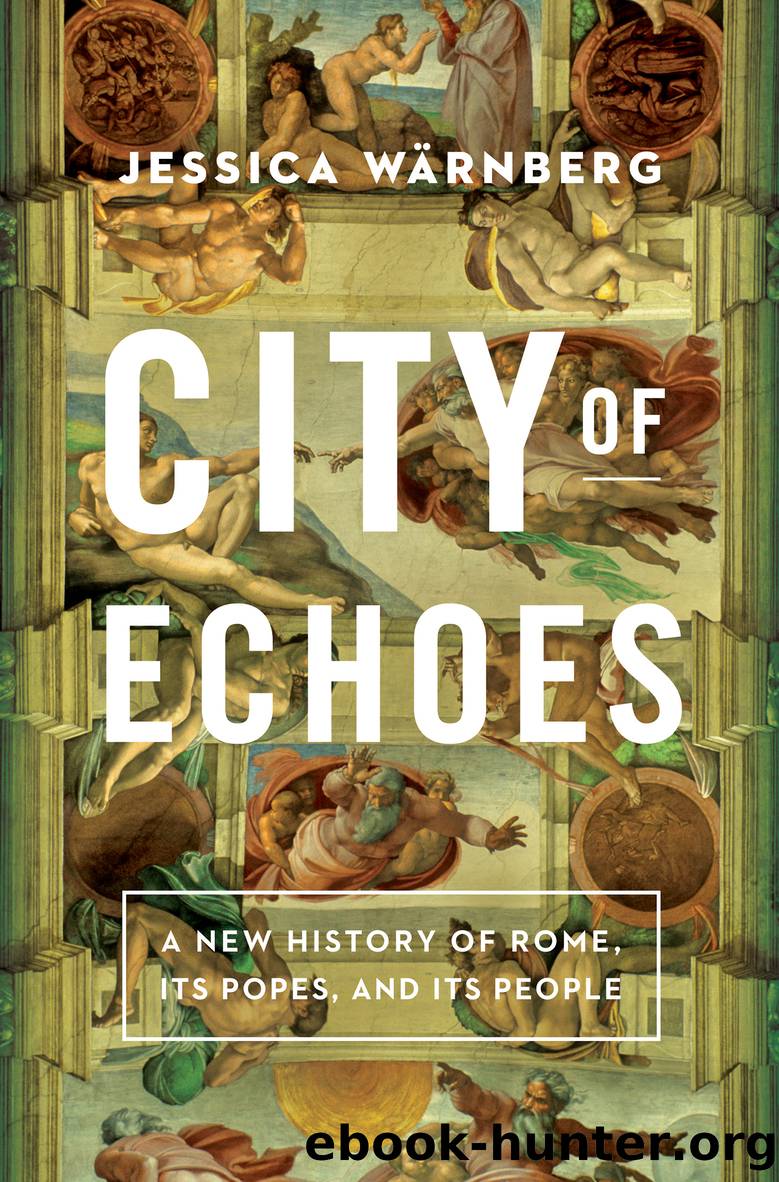City of Echoes by Jessica Wärnberg

Author:Jessica Wärnberg
Language: eng
Format: epub
Publisher: Pegasus Books
Published: 2023-09-05T00:00:00+00:00
* * *
The more permanent residents of Rome also indulged in this mania for the cityâs long-lost past. In the eighteenth century, Romans such as Francesco Ficoroni studied its ruins with all of the enthusiasm of those on the Grand Tour. Digging in the Vigna Moroni, a patch of land at the start of the Appian Way, Ficoroni unearthed and documented the relics of his ancient forebears, from dice of metal and fossilised stone to the masks of tragic theatre.32 Others in Rome sought to revive classical culture through immaterial means. On summer days from 1725, a group of men and women would gather to recite poetry in a theatre in the Bosco Parrasio, a lush garden atop the Janiculum Hill. In the winter, the group retreated to the Teatro degli Arcadi nearby at the Palazzo Salviati. Casting their minds back to the pastoral eclogues of ancient writers such as Virgil, this Academy of Arcadians aimed to purify Italian poetic literature of the ornament introduced in the age of the Baroque.
On 31 August 1776, they performed their most elaborate ceremony yet on the steps of the Capitoline Hill, crowning a poet known as Corilla Olimpica with laurels.33 Born Maria Maddalena Morelli in 1727, Corilla was the only female poet to receive this illustrious ancient honour, bestowed on men such as Tarquato Tasso and Francesco Petrarch in previous centuries. A Florentine, by then nearly fifty, Corilla became impassioned when she performed, reeling off torrents of poetry on ânew, surprising and wondrous thingsâ entirely improvised on the spot.34 She dazzled the Dukes of Tuscany, the aristocrats of Rome and, in Pisa, the infamous romantic adventurer Casanova. Conjuring yet more classical imagery, he claimed that she appeared âlike Venus as painted by the ancientsâ and that she âhad only to fix her squinting eyes on a man and the conquest was completeâ.35 Facing the Academy of Arcadians in Rome, Corilla had endured a far more gruelling task. To secure her laurels, they demanded that she improvise poetry on themes from ancient philosophy to optics and light.36 When the French author Germaine de Staël described the coronation of her heroine in the novel Corinne in 1807, some might have found its description of the event somewhat of a cliché. Lauded effusively as a woman of classical ideals, Corinne appears like a sage ancient Sybil as she is delivered to the Capitoline on a âchariot built in the style of ancient Romeâ.37 Yet Staël merely treated her protagonist as Corilla had been when she ascended that ancient hill to receive her prize, even if the author denied that she had been directly inspired by the events of 1776.
These classicising scenes in Rome appeared picturesque, but on closer inspection less charming details emerge. The custodian general of the Academy, Gioacchino Pizzi, had organised Corillaâs coronation after sundown, hoping â in vain â to spare her the taunts of those scandalised by her abandonment of her husband and child.38 Elsewhere in the city the antiquarian ideals of Francesco Ficoroni were also touched by contemporary reality.
Download
This site does not store any files on its server. We only index and link to content provided by other sites. Please contact the content providers to delete copyright contents if any and email us, we'll remove relevant links or contents immediately.
| Belgium | France |
| Germany | Great Britain |
| Greenland | Italy |
| Netherlands | Romania |
| Scandinavia |
Room 212 by Kate Stewart(4116)
The Crown by Robert Lacey(4115)
Endurance: Shackleton's Incredible Voyage by Alfred Lansing(3855)
The Iron Duke by The Iron Duke(3650)
The Rape of Nanking by Iris Chang(3526)
Killing England by Bill O'Reilly(3461)
Joan of Arc by Mary Gordon(3270)
Say Nothing by Patrick Radden Keefe(3069)
I'll Give You the Sun by Jandy Nelson(2846)
Hitler's Monsters by Eric Kurlander(2737)
Shadow of Night by Deborah Harkness(2731)
Margaret Thatcher: The Autobiography by Thatcher Margaret(2689)
Mary, Queen of Scots, and the Murder of Lord Darnley by Alison Weir(2682)
Darkest Hour by Anthony McCarten(2650)
Blood and Sand by Alex Von Tunzelmann(2611)
Red Famine: Stalin's War on Ukraine by Anne Applebaum(2470)
Eleanor & Park by Rainbow Rowell(2399)
The One Memory of Flora Banks by Emily Barr(2351)
Book of Life by Deborah Harkness(2273)
